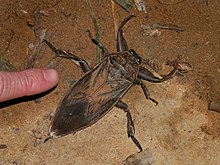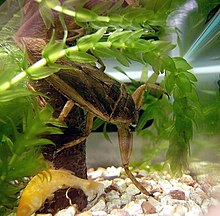Lethocerus
| Lethocerus Temporal range:
| |
|---|---|

| |
| Lethocerus americanus | |
| Scientific classification | |
| Domain: | Eukaryota |
| Kingdom: | Animalia |
| Phylum: | Arthropoda |
| Class: | Insecta |
| Order: | Hemiptera |
| Suborder: | Heteroptera |
| Family: | Belostomatidae |
| Subfamily: | Lethocerinae |
| Genus: | Lethocerus Mayr, 1853 |
| Species | |
|
See text | |
Lethocerus is a genus of the hemipteran family Belostomatidae, known colloquially as giant water bugs, toe biters and electric light bugs, distributed in tropical, subtropical and temperate areas of the world.[1][2] The greatest diversity of species occurs in the Americas, with only a single species in Europe, two in Africa, two in Australia and three in Asia.[2] It includes the largest true bugs with species capable of reaching a length of over 12 centimetres (4.7 in).[3] The South American L. grandis and L. maximus are the only species to commonly exceed 9 cm (3.5 in), with more typical lengths for the remaining species being between 4.5 and 9 cm (1.8 and 3.5 in).[2] Lethocerus sp. are distinguished from other genera in the Lethocerinae (Benacus and Kirkaldyia) by two symmetrical furrows in the inner pad of setae on the fore femur, the external borders of parasternites II and III narrowed and nearly straight, and with the setae of the tarsomeres following the line of the tibial setae.
Habits[edit]

Unlike giant water bugs in the subfamily Belostomatinae, females do not lay the eggs on the backs of males.[4] Instead, after copulation (often multiple sessions[5]) the eggs are laid on emergent vegetation (rarely on man-made structures) high enough above the waterline that the eggs will not be permanently submerged. The male then guards the eggs from predators and periodically brings water to the eggs to prevent their desiccation.[6]
Like other members of the giant water bug family, Lethocerus species are predators that overpower prey by stabbing it with the rostrum and injecting a saliva that includes a number of enzymes that break down proteins.[7] As many as 132 components have been found in their saliva or venom, several being similar to those found in assassin bugs.[8] The proboscis is then used to suck the liquified and semi-digested body fluid of the prey. The rostrum can also be used in self-defense, and their sting is very painful to humans, causing swelling and pulsating pain, but usually resolves within about five hours at most.[9]
Lethocerus adults are attracted to lights (hence the name electric light bug) and are attracted in large numbers as they disperse from one water body to another during the rainy season. Some species are eaten, particularly in Southeast Asia and a few are endangered.[10]
Species[edit]


As of 2006[update], this is an exhaustive listing of all known species of Lethocerus:[2]
- Lethocerus americanus
- Lethocerus angustipes
- Lethocerus annulipes
- Lethocerus bruchi
- Lethocerus camposi
- Lethocerus collosicus
- Lethocerus cordofanus
- Lethocerus delpontei
- Lethocerus dilatus
- Lethocerus distinctifemur
- Lethocerus grandis
- Lethocerus indicus
- Lethocerus insulanus
- Lethocerus jimenezasuai
- Lethocerus maximus
- Lethocerus mazzai
- Lethocerus medius
- Lethocerus melloleitaoi
- Lethocerus oculatus
- Lethocerus patruelis
- Lethocerus truxali
- Lethocerus uhleri
The oldest known fossil of the genus is an indeterminate species from the Bembridge Marls, Isle of Wight, UK.[11]
In addition to these, Lethocerus deyrollei, which is one of the best known giant water bugs, has traditionally been included in this genus, but in 2006 it was moved to Kirkaldyia.[2]
References[edit]
- ^ D. R. Lauck & A. Menke (1961). "The higher classification of the Belostomatidae (Hemiptera)". Annals of the Entomological Society of America. 54 (5): 644–657. doi:10.1093/aesa/54.5.644.
- ^ a b c d e f g P. J. Perez-Goodwyn (2006). "Taxonomic revision of the subfamily Lethocerinae Lauck & Menke (Heteroptera: Belostomatidae)". Stuttgarter Beiträge zur Naturkunde. A (Biologie). 695: 1–71.
- ^ Haddad Jr; Schwartz; Schwartz; and Carvalho (2010). Bites Caused by Giant Water Bugs Belonging to Belostomatidae Family (Hemiptera, Heteroptera) in Humans: A Report of Seven Cases. Wilderness & Environmental Medicine 21: 130–133.
- ^ Ichikawa, Noritaka (1988). "Male brooding behaviour of the giant water bugLethocerus deyrollei vuillefroy (Hemiptera: Belostomatidae)". Journal of Ethology. 6 (2): 121–127. doi:10.1007/BF02350877. ISSN 0289-0771. S2CID 7243491.
- ^ Ichikawa, Noritaka (1989). "Repeated copulations benefit of the female in Lethocerus deyrollei vuillefroy (Heteroptera: Belostomatidae)". Journal of Ethology. 7 (2): 113–117. doi:10.1007/BF02350032. ISSN 0289-0771. S2CID 27391228.
- ^ Smith, Robert L.; Larsen, Eric (1993). "Egg attendance and brooding by males of the giant water bugLethocerus medius (Guerin) in the field (Heteroptera: Belostomatidae)". Journal of Insect Behavior. 6 (1): 93–106. doi:10.1007/BF01049150. ISSN 0892-7553. S2CID 13472284.
- ^ Rees, A. R.; Offord, R. E. (1969). "Studies on the Protease and Other Enzymes from the Venom of Lethocerus cordofanus". Nature. 221 (5181): 675–677. doi:10.1038/221675a0. ISSN 0028-0836. PMID 5774947. S2CID 4177402.
- ^ Walker, Andrew A.; Hernández-Vargas, Maria José; Corzo, Gerardo; Fry, Bryan G.; King, Glenn F. (2018). "Giant fish-killing water bug reveals ancient and dynamic venom evolution in Heteroptera". Cellular and Molecular Life Sciences. 75 (17): 3215–3229. doi:10.1007/s00018-018-2768-1. ISSN 1420-682X. PMID 29427076. S2CID 253598647.
- ^ Haddad, Vidal; Schwartz, Elisabeth F.; Schwartz, Carlos Alberto; Carvalho, Lucélia Nobre (2010). "Bites Caused by Giant Water Bugs Belonging to Belostomatidae Family (Hemiptera, Heteroptera) in Humans: A Report of Seven Cases". Wilderness & Environmental Medicine. 21 (2): 130–133. doi:10.1016/j.wem.2010.01.002. PMID 20591375.
- ^ Yoon, Tae Joong; Kim, Dong Gun; Kim, Seon Yi; Jo, Shin Il; Bae, Yeon Jae (2010). "Light-attraction flight of the giant water bug, Lethocerus deyrolli (Hemiptera: Belostomatidae), an endangered wetland insect in East Asia". Aquatic Insects. 32 (3): 195–203. doi:10.1080/01650424.2010.508045. ISSN 0165-0424. S2CID 83801153.
- ^ Szwedo, Jacek; Drohojowska, Jowita; Popov, Yuri A.; Simon, Ewa; Wegierek, Piotr (September 2019). "Aphids, true hoppers, jumping plant-lice, scale insects, true bugs and whiteflies (Insecta: Hemiptera) from the Insect Limestone (latest Eocene) of the Isle of Wight, UK". Earth and Environmental Science Transactions of the Royal Society of Edinburgh. 110 (3–4): 331–396. doi:10.1017/S175569101900001X. ISSN 1755-6910. S2CID 202183876.
